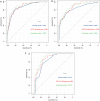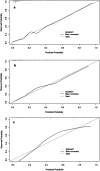CT-Based Intratumoral and Peritumoral Radiomics Nomograms for the Preoperative Prediction of Spread Through Air Spaces in Clinical Stage IA Non-small Cell Lung Cancer
- PMID: 38343212
- PMCID: PMC11031508
- DOI: 10.1007/s10278-023-00939-1
CT-Based Intratumoral and Peritumoral Radiomics Nomograms for the Preoperative Prediction of Spread Through Air Spaces in Clinical Stage IA Non-small Cell Lung Cancer
Abstract
The study aims to investigate the value of intratumoral and peritumoral radiomics and clinical-radiological features for predicting spread through air spaces (STAS) in patients with clinical stage IA non-small cell lung cancer (NSCLC). A total of 336 NSCLC patients from our hospital were randomly divided into the training cohort (n = 236) and the internal validation cohort (n = 100) at a ratio of 7:3, and 69 patients from the other two external hospitals were collected as the external validation cohort. Univariate and multivariate analyses were used to select clinical-radiological features and construct a clinical model. The GTV, PTV5, PTV10, PTV15, PTV20, GPTV5, GPTV10, GPTV15, and GPTV20 models were constructed based on intratumoral and peritumoral (5 mm, 10 mm, 15 mm, 20 mm) radiomics features. Additionally, the radscore of the optimal radiomics model and clinical-radiological predictors were used to construct a combined model and plot a nomogram. Lastly, the ROC curve and AUC value were used to evaluate the diagnostic performance of the model. Tumor density type (OR = 6.738) and distal ribbon sign (OR = 5.141) were independent risk factors for the occurrence of STAS. The GPTV10 model outperformed the other radiomics models, and its AUC values were 0.887, 0.876, and 0.868 in the three cohorts. The AUC values of the combined model constructed based on GPTV10 radscore and clinical-radiological predictors were 0.901, 0.875, and 0.878. DeLong test results revealed that the combined model was superior to the clinical model in the three cohorts. The nomogram based on GPTV10 radscore and clinical-radiological features exhibited high predictive efficiency for STAS status in NSCLC.
Keywords: Nomogram; Non-small cell lung cancer; Prediction; Radiomics; Spread through air spaces.
© 2024. The Author(s).
Conflict of interest statement
The authors declare no competing interests.
Figures






Similar articles
-
Nomogram based on clinical characteristics and radiological features for the preoperative prediction of spread through air spaces in patients with clinical stage IA non-small cell lung cancer: a multicenter study.Diagn Interv Radiol. 2023 Nov 7;29(6):771-785. doi: 10.4274/dir.2023.232404. Epub 2023 Sep 19. Diagn Interv Radiol. 2023. PMID: 37724737 Free PMC article. Clinical Trial.
-
Nomogram using intratumoral and peritumoral radiomics for the preoperative prediction of visceral pleural invasion in clinical stage IA lung adenocarcinoma.J Cardiothorac Surg. 2024 May 31;19(1):307. doi: 10.1186/s13019-024-02807-7. J Cardiothorac Surg. 2024. PMID: 38822379 Free PMC article.
-
Intratumoral and peritumoral radiomics combined with computed tomography features for predicting the invasiveness of lung adenocarcinoma presenting as a subpleural ground-glass nodule with a consolidation-to-tumor ratio ≤50.J Thorac Dis. 2024 Aug 31;16(8):5122-5137. doi: 10.21037/jtd-24-243. Epub 2024 Aug 28. J Thorac Dis. 2024. PMID: 39268144 Free PMC article.
-
Intratumoral and peritumoral radiomics nomograms for the preoperative prediction of lymphovascular invasion and overall survival in non-small cell lung cancer.Eur Radiol. 2023 Feb;33(2):947-958. doi: 10.1007/s00330-022-09109-3. Epub 2022 Sep 6. Eur Radiol. 2023. PMID: 36064979 Clinical Trial.
-
Diagnostic performance of radiomics analysis for pulmonary cancer airway spread: a systematic review and meta-analysis.Diagn Interv Radiol. 2025 Apr 28;31(3):215-225. doi: 10.4274/dir.2024.242852. Epub 2025 Apr 7. Diagn Interv Radiol. 2025. PMID: 40192338 Free PMC article.
Cited by
-
Deep Learning Analysis for Predicting Tumor Spread through Air Space in Early-Stage Lung Adenocarcinoma Pathology Images.Cancers (Basel). 2024 Jun 3;16(11):2132. doi: 10.3390/cancers16112132. Cancers (Basel). 2024. PMID: 38893251 Free PMC article.
-
A Bayesian deep learning model with consolidation-to-tumor ratio (CTR) prior revolutionizes the prediction of spread through air spaces (STAS) in stage IA lung adenocarcinoma: a large-scale diagnostic study.Transl Lung Cancer Res. 2025 May 30;14(5):1516-1530. doi: 10.21037/tlcr-24-890. Epub 2025 May 27. Transl Lung Cancer Res. 2025. PMID: 40535077 Free PMC article.
-
Habitat-based CT radiomics enhances the ability to predict spread through air spaces in stage T1 invasive lung adenocarcinoma.Front Oncol. 2024 Oct 11;14:1436189. doi: 10.3389/fonc.2024.1436189. eCollection 2024. Front Oncol. 2024. PMID: 39464700 Free PMC article.
-
Research hotspots and trends in lung cancer STAS: a bibliometric and visualization analysis.Front Oncol. 2025 Jan 3;14:1495911. doi: 10.3389/fonc.2024.1495911. eCollection 2024. Front Oncol. 2025. PMID: 39830648 Free PMC article.
-
STAS: New explorations and challenges for thoracic surgeons.Clin Transl Oncol. 2025 Apr;27(4):1345-1355. doi: 10.1007/s12094-024-03681-4. Epub 2024 Sep 4. Clin Transl Oncol. 2025. PMID: 39230858 Review.
References
Grants and funding
LinkOut - more resources
Full Text Sources
